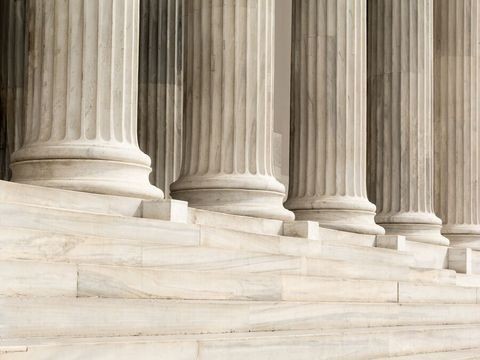Federal Circuit Finds Computer-Readable Recording Medium Storing Instructions Patent-Eligible
What You Need to Know
Key takeaway #1
Whether a “computer-readable medium” includes transitory media depends primarily on the intrinsic evidence provided by a patent
Key takeaway #2
Extrinsic evidence that contradicts intrinsic evidence should not be relied on
Client Alert | 2 min read | 05.02.23
In the April 12, 2023 decision in Sequoia Technology, LLC v. Dell, Inc., No. 21-2263, a case involving infringement and validity of a patent related to digital storage of data in a server, the Federal Circuit reversed the district court, in part, and held that a “computer-readable recording medium storing instructions” does not encompass transitory media.
The district court consolidated a group of cases and referred the claim construction disputes to a magistrate judge who adopted a claim construction in which “computer-readable medium” (CRM) included transitory media (i.e., signals or waves), which are patent-ineligible. The magistrate judge’s claim construction was based, at least in part, on extrinsic evidence provided by an expert witness that related to 34 different patents and patent applications with different express definitions of CRM that included transitory media. The district court relied on, not only the magistrate judge’s Report and Recommendation, but also the lack of a clear statement in the specification of the patent that the CRM excluded transitory media.
Based on the intrinsic evidence in the case, the Federal Circuit disagreed with the district court. The Court noted that instead of reciting “computer-readable medium,” the claim of the patent recited the narrower limitation “computer-readable recording medium storing instructions.” The court agreed that one of ordinary skill in the art would not understand transitory signals to record or store instructions in memory systems. Further, the Court recognized that the claim recited “creating the logical volume … in a physical storage space” and “storing [sic] metadata to the disk partitions,” which demonstrate that the claim is directed to a non-transient storage medium.
In addition to the claim itself, the Court found more intrinsic evidence supporting its claim construction in the specification, which discloses only non-transitory media in its list of examples of CRM (i.e., CDROM, RAM, and various types of disks). Although the specification used the term “including,” which is generally considered to be an open-ended term, where it recites “a computer readable medium including … (CDROM), … (RAM), … and magneto-optical disk,” the Court concluded that the context of the entire patent makes clear that the term “computer-readable medium” cannot encompass transitory media. The Court further stated that the term “non-transitory” need not be explicitly used in the claims or specification, where the intrinsic record demonstrates that the CRM does not reasonably include transitory media.
The Federal Circuit decided that the district court erred in relying on the expert testimony, because it was inconsistent with the intrinsic evidence and because it was based on different express definitions of CRM in patent specifications directed to different inventions. In its discounting of the expert testimony, the Court stated “extrinsic evidence of what other inventors chose to do cannot surmount the intrinsic evidence of what the inventors chose here; context is the key in claim construction.”
This decision makes clear that “computer-readable recording medium storing instructions” is generally considered to be a patent-eligible way to recite a CRM. Moreover, the decision provides a valuable reminder concerning the value of intrinsic evidence in a patent.
Contacts
Insights
Client Alert | 5 min read | 12.12.25
Eleventh Circuit Hears Argument on False Claims Act Qui Tam Constitutionality
On the morning of December 12, 2025, the Eleventh Circuit heard argument in United States ex rel. Zafirov v. Florida Medical Associates, LLC, et al., No. 24-13581 (11th Cir. 2025). This case concerns the constitutionality of the False Claims Act (FCA) qui tam provisions and a groundbreaking September 2024 opinion in which the United States District Court for the Middle District of Florida held that the FCA’s qui tam provisions were unconstitutional under Article II. See United States ex rel. Zafirov v. Fla. Med. Assocs., LLC, 751 F. Supp. 3d 1293 (M.D. Fla. 2024). That decision, penned by District Judge Kathryn Kimball Mizelle, was the first success story for a legal theory that has been gaining steam ever since Justices Thomas, Barrett, and Kavanaugh indicated they would be willing to consider arguments about the constitutionality of the qui tam provisions in U.S. ex rel. Polansky v. Exec. Health Res., 599 U.S. 419 (2023). In her opinion, Judge Mizelle held (1) qui tam relators are officers of the U.S. who must be appointed under the Appointments Clause; and (2) historical practice treating qui tam and similar relators as less than “officers” for constitutional purposes was not enough to save the qui tam provisions from the fundamental Article II infirmity the court identified. That ruling was appealed and, after full briefing, including by the government and a bevy of amici, the litigants stepped up to the plate this morning for oral argument.
Client Alert | 8 min read | 12.11.25
Director Squires Revamps the Workings of the U.S. Patent Office
Client Alert | 8 min read | 12.10.25
Creativity You Can Use: CJEU Clarifies Copyright for Applied Art
Client Alert | 4 min read | 12.10.25
Federal Court Strikes Down Interior Order Suspending Wind Energy Development



